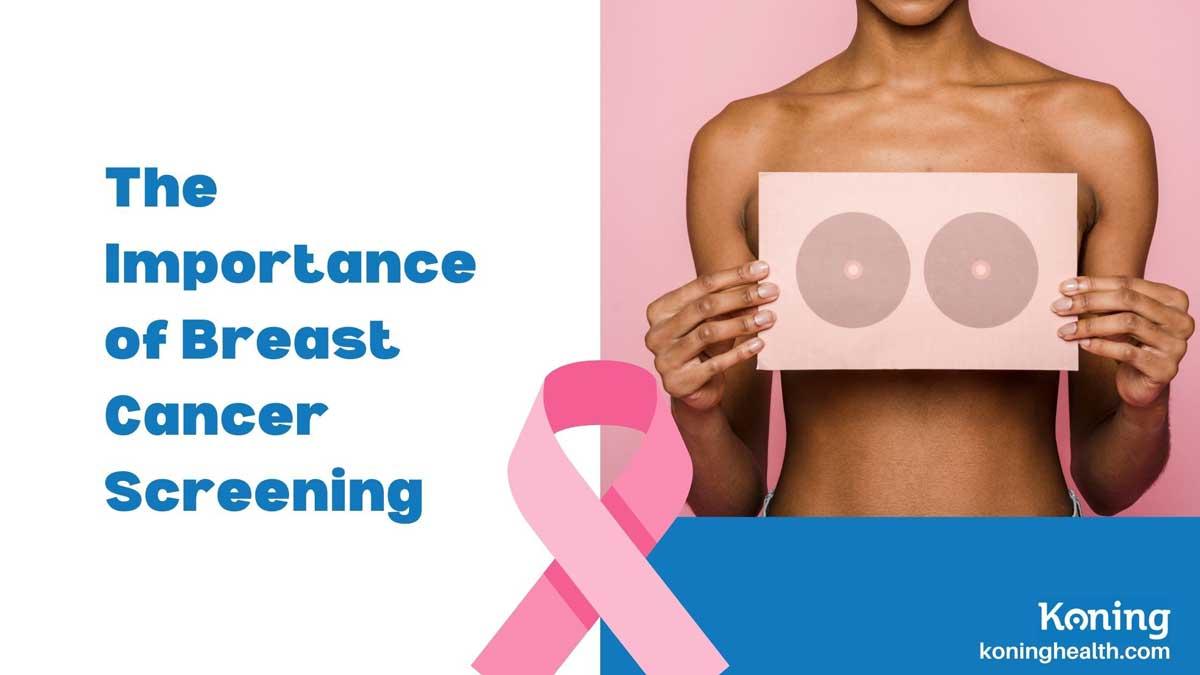
- Blog /
- October 18, 2021
The Importance of Breast Cancer Screening
Routine breast exams are a common practice in modern medicine used to rule out breast cancer and maintain breast health in women over forty and, in rare cases, to ensure breast health in men. Breast cancer is the second most leading cancer among women in the United States.
In 2020, there were 2.3 million women diagnosed with breast cancer and 685,000 deaths globally. Although breast exams do not prevent cancer from happening, early detection can make the treatment process easier.
Breast exams are important because early detection of breast cancer leads to more thorough treatment and intervention. These exams are not only recommended and conducted solely when a patient has symptoms, but also should be considered routine because of the prevalence of cancer among women.
As the estimated numbers of breast cancer findings increase each year, newer and more efficient methods of conducting breast screenings are needed. Koning offers a solution using the Koning Breast CT (KBCT), a breast imaging device that produces true 3D images of the breast. The KBCT simultaneously improves the way a clinician visualizes and evaluates breast tissue while also improving a patient’s experience during exams.
Breast Screening Options
Men and women need guidance from health professionals about the best breast screening options. Health care providers understand the importance of breast exams, and often see the repercussions of diagnosing cancer in the late stages. A provider’s advice for breast cancer screenings relies on the specific needs of a patient, and the available imaging resources.
Standard Mammogram
Standard mammography referred to as a ‘mammogram’ is a well-known method of conducting breast exams, but is often overlooked by patients because of the painful experience and occurrence of false positives or false negatives.
Mammography tests result in 2D imaging with limited angles and are uncomfortable because breasts must be compressed between two plates. Standard mammograms have been used routinely for years, but during the COVID-19 pandemic, healthcare professionals saw a plummeting rate in the adherence of routine mammograms amongst female patients in the U.S.
Breast Self-Exam
Breast self-exams are another common method and can be done by feeling for lumps or abnormalities in one’s breasts. This method is cost-effective and can be conducted more frequently.
Research has shown that self-exams led to a small percentage of breast cancer findings in women, either through the self-exam or by accident. Patients can benefit from the use of self-exams in addition to other screening options, but it is important to note that self-exams should not be the sole method used when looking for breast cancer.
Breast Ultrasound
Breast ultrasounds are usually not conducted alone but are used in addition to a mammogram. A breast ultrasound uses sound waves to show the inside of breasts. Ultrasounds will show changes in mammograms or test to find abnormalities that might not have been revealed through conventional mammograms.
Diagnostic mammograms and ultrasounds are used in men and women that have undergone breast cancer treatment in the past.
Magnetic Resonance Imaging
The use of breast MRIs is most commonly used among women with dense breasts, and those who have a higher risk of breast cancer. An MRI is more likely than a mammogram to find a breast mass. Healthcare providers like physicians, radiologists, and oncologists have found that in addition to a patient’s genetic testing, strong family history of breast cancer, and cofounding gene changes in BRCA1 and BRCA2, MRI’s have aided in confirming whether or not a lesion is malignant.
MRIs aren’t always the first choice for breast imaging since they can be more costly than a mammogram. The MRI is also often used after another testing method has been exhausted.
Computed Tomography
A CT uses different angles of x-rays to show various detailed images in the body using a computer. CTs often help radiologists detect lesions of benign or suspicious morphology due to their larger field of view and improved contrast resolution.
The Koning Way
Featured in many publications, the KBCT offers differentiation from the common patient experience and provides clinical results similar to or better than traditional methods of breast cancer screenings. Using the KBCT results in true 3D images of breast tissue from a circumferential view. Unlike a routine mammogram, the KBCT does not involve painful breast compression. It can be used on women with dense or fatty breasts and conducts the imaging in a rapid 10-second exposure with comparable radiation levels to that of diagnostic mammograms.
The detector in the KBCT surrounds the entirety of the breast, assuring cancer won’t go undetected. By providing more comfort to patient experience and visualizing breast tissue through KBCT technology, health care providers can replace unnecessary procedures in breast cancer screening. Refraining from using multiple testing methods when unneeded will also save time and costs.
The Future for Breast Cancer Screening
This past year has shown a significant decrease in breast cancer screening adherence during the COVID-19 pandemic despite the estimated numbers of breast cancer findings amongst women in the U.S.
Patients and providers alike need the best resources and methods to conduct these routine exams with the least amount of harm or error. Standard mammograms miss 30% of cancers, preventing women from the benefit of early detection and the opportunity for a better prognosis. For that reason, the use of KBCT has been expanding to imaging facilities across the globe.
KBCT has revolutionized breast imaging and created a new definition of what it means to have a routine breast exam. The fight against breast cancer continues, but the KBCT will help minimize breast cancer occurrences and improves patients and providers' experience.
For more, read 8 Ways To Live A Healthier Lifestyle.
